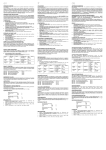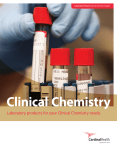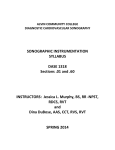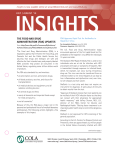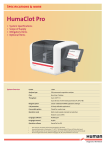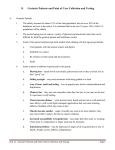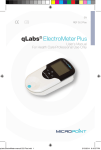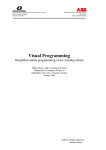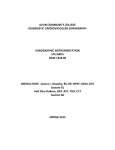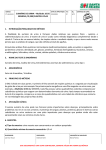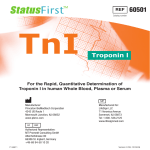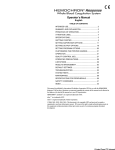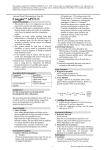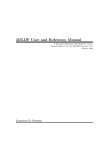Download Coagulation
Transcript
COLA’s MaY / June ‘11 insights Into Coagulation ALSO IN THIS ISSUE: Letter from the Chair . . . . . . . . . . . . . . . . . . . . . . . . . . . . . . 2 Coagulation. . . . . . . . . . . . . . . . . . . . . . . . . . . . . . . . . . . . . . . . . . . . . 3 Significance of the International Normalized Ratio (INR). . . . . . . . . . . . . . . . . . . . . . . . . . . . 4 Comparison of Point-of-Care Coagulation Systems. . . . . . . . . . . . . . . . . . . . . . . . . . . . . . . 5 Advertisements . . . . . . . . . . . . . . . . . . . . . . . . . . . . . . . . 7 & 10 Urgent Medical Device Correction Update/Recall Notices . . . . . . . . . . . . . . . . . . . . . . . . . . . 14 COLA Technical Bulletins . . . . . . . . . . . . . . . . . . . . . . . 24 IMPORTANT RECALL INFORMATION Starting on Page 14 From The ChaIr “Bittersweet.” That is the best way to describe this moment: the end of my term as Chair of COLA’s Board of Directors. Much like a high school or college graduate, I have a sadness that this period in my life is ending. Also like the graduate, I can look back over the last two years with pride in the organization’s accomplishments. • COLA has maintained its status as the largest accrediting agency granted deemed status by CMS. • Of the 7600 labs that COLA accredits, approximately 3600 were surveyed in the last year. Nearly a quarter of those (22.5%) achieved perfect surveys. • To promote quality patient care, we implemented a program designed specifically for waived labs, to help ensure that personnel learn about and implement Good Laboratory Practices. • We launched COLAcentral to assist our laboratories with their compliance, training, and documentation management needs. COLAcentral also helps us provide better customer service through alert messages and easy access to educational products. • We’ve made strides in the educational arena also. - The Symposium for Clinical Laboratories has continued to grow – in number of attendees, in variety of exhibitors, and in diversity of educational session topics. We strive to update you on as many themes as possible from regulatory changes to laboratory business operations to scientific advances. - Many of our online courses and down-loadable products have been reviewed and revised to keep you up-to-date on the latest information in laboratory medicine. - We’ve created educational webinars that address specific issues seen during laboratory surveys. • Our newest endeavor, www.COLAinsider.org, highlights COLA achievements and staff members as well as interesting news from laboratory medicine, to help us stay connected to you. - Our new Compliance Tips and Technical Bulletins were prepared with you in mind. As the title suggests, the Compliance Tips provide you with helpful hints to maintain regulatory compliance. The Technical Bulletins address changes in criteria, testing method alerts, and other technical issues that you will find useful and informative. • We’ve improved our internal operations. Since January 2010, COLA has implemented a metrics system to measure and monitor internal processes and progress. Our main goal is to streamline our processes to provide you with the best service possible. - Even Insights has undergone changes. The most noticeable change is the switch to the electronic format. Without restrictions imposed by printing and mailing costs, we can jam-pack every issue with information valuable to your laboratory. Perhaps our most notable accomplishment is our recently obtained certification under ISO Standard 9001:2008, which makes COLA the only accreditation organization deemed by CMS to achieve this status. By obtaining certification through the International Organization for Standardization (ISO), COLA demonstrates our willingness to “walk the walk” by subjecting ourselves to the same kind of third party review our surveyors perform for you, our customers. Through this structured process, you can assure your patients that COLA, as well as our laboratories, meet standards rigorously tested by a third party. I am heartened by the fact that I am leaving COLA in the very capable hands of Dr. James Stackhouse, who becomes Chair in July 2011. He can certainly relate to the majority of our clients as he is certified in Internal Medicine and maintains a private practice in North Carolina. He has also volunteered with numerous medical, professional and governmental bodies and has served them in many capacities. Additionally, he is a Clinical Assistant Professor in the Department of Medicine at the University of North Carolina School of Medicine. This final fact ensures COLA’s emphasis on education will be maintained since he holds education in such high regard. 2 erlin K. Janzen, MD, FAAFP V Chair, COLA Board of Directors C O L A’ s inSights M ay / J u n e ‘ 1 1 COVER STORY Coagulation The complex process by which blood forms clots Did you know that every time you bang your hand on a stair rail, or twist your ankle, your body starts forming blood clots at the injury site? Our bodies form blood clots all the time (through a process known as hemostasis), even when we do not remember the hit or bump. So why aren’t we one big clot? ... Because of the remarkable biological feedback systems in our bodies. In addition to the coagulation-promoting factors, there are also substances in blood which inhibit coagulation. Whether or not blood coagulates depends on the balance that exists between the two groups of factors (pro-coagulants and anti-coagulants). When a body tissue is injured and begins to bleed, it initiates a sequence of clotting factor activities – the coagulation cascade – leading to the formation of a blood clot. This cascade is comprised of three pathways: extrinsic, intrinsic, and common. Two laboratory tests are commonly used to evaluate coagulation disorders: Prothrombin Time/International Normalized Ratio (PT/INR) which measures the integrity of the extrinsic system, as well as factors common to both systems, and Activated Partial Thromboplastin Time (aPTT), which measures the integrity of the intrinsic system and the common components. When body tissue is injured and begins to bleed, it initiates a sequence of clotting factor activities - the coagulation cascade leading to the formation of a blood clot. This cascade is comprised of three pathways: extrinsic, intrinsic, and common. Two laboratory tests are commonly used to evaluate coagulation disorders: Prothrombin Time (PT/INR) which measures the integrity of the extrinsic system as well as factors common to both systems, and Activated Partial Thromboplastin Time (aPTT), which measures the integrity of the intrinsic system and the common components. Blood Clot Formation Clot formation is a function of plasma. It depends upon the orderly interaction of a group of plasma proteins (which are sequentially activated following vascular injury) with phospholipids (from either damaged tissue or platelets) and calcium ions (Ca++). The final stages include the formation of thrombin, which then converts soluble plasma protein fibrinogen to insoluble fibrin. Another factor converts the fibrin into a cross-linked polymer which stabilizes the platelet plug and traps red blood cells (RBCs) in the meshwork to form the actual blood clot. See Figure 11. Depending on the type of vascular damage or abnormality, clot formation can be initiated and proceed according to two different cascading pathways: the intrinsic (initiated by contact with an abnormal/foreign surface) or the extrinsic (initiated by exposure to tissue factors). Please keep in mind: • The two pathways converge, so the final steps (the common pathway) are common to both schemes. • Clotting can be initiated via either pathway: the more rapid (15-20 secs) extrinsic scheme or the slower (2-6 mins) intrinsic scheme. • The division into two pathways is only an artifact of in vitro testing: the two pathways interconnect at several levels. In vivo, both pathways must be activated for effective hemostasis. • Both coagulation pathways, by a series of feedback mechanisms, control their own activity (e.g. traces of thrombin enhance the activity of earlier factors in the scheme). Figure 1 Thrombin is the master regulator of the coagulation cascade. It converts fibrinogen to fibrin in order to form a loose fibrin clot. Thrombin also activates Factor XIII, or transglutaminase, to form stabilizing covalent bonds within the fibrin strands to activate more platelets and form a stronger clot. Finally, thrombin activates Factors V and VIII in a positive feedback mechanism so the clotting cascade is self-regulating and knows when to ‘turn off’. >> Continued on page 6 COLA Information Resource Center 800.981.9883 | www.cola.org | www.LabUniversity.org | www.COLAcentral.com 3 Significance of the International Normalized Ratio (INR) Variables affecting Blood coagulation As stated in the cover article, blood coagulation is affected by many different variables. These occur within the extrinsic, intrinsic and/or common pathways of the coagulation cascade or they can be external to the cascade. When performing laboratory testing to assess the coagulation process, there are even more variables to consider. Establishment of the INR The International Normalized Ratio (INR) was established to minimize the effects of testing variables on PT results including: • Differences in reagents and instrumentation used by different laboratories • Differences in reagents over time within the same laboratory • Differences in reagent lots This assures clinicians that changes in PT results are due to changes in patient status, rather than testing variables. The ISI value is critical in the calculation of the INR since it is the exponent in the formula, which means that even small errors in assigning the ISI value can result in substantial errors in the INR calculation. Prothrombin Time (PT) is a lab test that measures the time it takes for a clot to form; therefore, the result is reported in seconds. PT evaluates the extrinsic and common pathways of the coagulation cascade, including the following coagulation factors: fibrinogen (factor I), prothrombin (factor II), factor V, factor VII and factor IX. If any of these factors is deficient and/or functioning abnormally, the PT will be prolonged. This test is also used to monitor and adjust the treatment of patients who are receiving oral anticoagulant therapy, i.e., patients who are taking “blood thinners” (warfarin or Coumadin®). The activated Partial Thromboplastin Time (aPTT), also measures the time it takes for a clot to form and is also reported in seconds. It differs from the PT test in that it evaluates the intrinsic and common coagulation pathways, including the following factors: XII, XI, IX, VIII, X, V, II (prothrombin) and I (fibrinogen). Deficiencies and/or functional abnormalities of all the major clotting factors can be detected when evaluating PT and aPTT results concurrently. Since many clotting factors are produced by the liver and require vitamin K to mature, these tests will also be affected by liver disease/damage and vitamin K deficiency. The INR has standardized PT results nationally and internationally by adjusting for changes in thromboplastin, the reagent used in the PT test. This allows a consistent evaluation of results from different laboratories, which allows the patient to travel and still obtain comparable test results. The INR was established in the early 1980s by the International Committee on Thrombosis and Hemostasis (ICTH) and the World Health Organization (WHO). It is not a new laboratory test; it is a mathematical calculation to account for the variability of the PT reagent: INR = (PT patient/PT normal)ISI • The “PT patient” is the PT result of the patient (reported in seconds). • The “PT normal” is determined by the laboratory utilizing their particular reagent / instrument combination. It is the mean (reported in seconds) of a 20 – 30 patient normal study. This normal study is performed whenever the reagent lot and/or the instrument changes. • The ISI is determined by the thromboplastin manufacturer and varies with each lot of reagent. The reagent lot is compared to a calibrated, internationally accepted, standard reference preparation of thromboplastin, which has an ISI value of 1.0. By definition, the more sensitive reagent lots have an ISI of less than 1.0 and the less sensitive lots have an ISI value greater than 1.0. >> Continued on page 10 4 C O L A’ s inSights M ay / J u n e ‘ 1 1 Comparison of Point-of-Care Coagulation Systems This article consists of information available on the ITC 1 & Roche Diagnostics 2 websites Several different point-of-care coagulation testing devices are currently available. They range from waived meters available for home use to non-waived instruments that perform multiple coagulation tests. Attributes of six different systems are featured here. Hemochron Signature Plus The ITC Hemochron® Signature Plus Microcoagulation System offers point-of-care monitoring with numerous features to meet the needs of each individual department, as well as the needs of regulatory compliance. It is a small, battery-operated, hand-held instrument that performs individual point-of-care coagulation tests on fresh or citrated whole blood. These tests include: Activated Clotting Time (ACT+ and ACT-LR), Activated Partial Thromboplastin Time (aPTT and aPTT Citrate), and Prothrombin Time (PT/INR and PT/INR Citrate). The system is intended to be used only with test cuvettes that are available from ITC. Data management capabilities of the instrument include storage of up to 400 patient results and 400 quality control results, designation of quality control levels, tagging of test results with date and time, entry of Patient ID and/or Operator ID, and printing of results. HEMOCHRON Configuration Manager software, included with the system, allows the user to connect a personal computer to an instrument and perform system configuration functions using the fast and convenient Microsoft Windows user interface. ITC data management software programs, available separately, allow the user to connect a personal computer to an instrument and perform various data management and data reporting functions. Hemochron Signature Elite The ITC Hemochron® Signature Elite is a simple, easy-to-use, portable microcoagulation system that can enhance compliance and patient safety. Hemochron’s extensive menu allows for the standardization of point of care coagulation throughout the facility. The Signature Elite integrates data management and connectivity and connects to most major data management systems. It is a small, battery-operated, hand-held instrument that performs individual point-of-care coagulation tests on fresh or citrated whole blood. These tests include: Activated Clotting Time (ACT+ and ACT-LR), Activated Partial Thromboplastin Time (aPTT and aPTT Citrate), and Prothrombin Time (PT/INR and PT/INR Citrate). The system is intended to be used only with test cuvettes that are available from ITC. Data management capabilities of the instrument include storage of up to 600 patient results and 600 quality control results, designation of quality control levels, tagging of test results with date and time, entry of Patient ID and/or Operator ID or Operator PIN, and printing of results. HEMOCHRON Configuration Manager software, which is included with the system, allows the user to connect a personal computer to the instrument and perform system configuration functions using the fast and convenient Microsoft Windows user interface. HEMOCHRON ReportMaker software, available separately, allows the user to connect a personal computer to an instrument and perform various data management and data reporting functions. ProTime The ITC ProTime® Microcoagulation System is a portable, AC or battery operated, PT/INR testing instrument designed to allow healthcare professionals and/or patients to safely monitor the clotting activity of patients on oral anticoagulant therapy. The test procedure is simple and safe, and performance is comparable to laboratory testing. The system utilizes a disposable, self-contained, micro-volume reaction cell cuvette and a drop of whole blood from a fingerstick or anticoagulant-free venous blood sample. The ProTime system consists of the ProTime instrument, the reagent cuvette with built-in quality control (QC), and the Tenderlett® Plus sample collection system. The instrument and cuvette QC function together to ensure correct sample size, collection technique, test procedure, device functionality and reagent integrity, which helps ensure accurate results each time the test is performed. Two types of cuvettes are available for use with the ProTime system. One type has a three channel set-up to run the integrated two-level QC along with the patient test. The second type has five micro-channels to perform patient testing in triplicate in addition to the two levels of quality control. >> Continued on page 11 COLA Information Resource Center 800.981.9883 | www.cola.org | www.LabUniversity.org | www.COLAcentral.com 5 Continued from Page 3 COAGULATION In total, we have 13 numbered protein clotting factors, in addition to Prekallikrein and high molecular weight kininogen (HMWK), which don’t have numbers associated with them. All are necessary for effective coagulation. All factors are made in the liver, except for Factor VIII which is synthesized in endothelial cells. Vitamin K is needed to make prothrombin and other clotting factors. The following table describes each clotting factor along with its number (if it has one) and its function. Coagulation Factors and Related Substances Number and/or Name Function I (fibrinogen) Forms clot (fibrin) II (prothrombin) Its active form (IIa) activates I, V, VII, VIII, XI, XIII, protein C, platelets Tissue factor Co-factor of VIIa (formerly known as factor III) Calcium equired for coagulation factors to bind to phospholipid R (formerly known as factor IV) V (proaccelerin, labile factor) Co-factor of X with which it forms the prothrombinase complex VI Unassigned – old name of Factor Va VII (stable factor, proconvertin) Activates IX, X VIII (Antihemophilic factor A) Co-factor of IX with which it forms the tenase complex IX (Antihemophilic factor B or Christmas factor) Activates X: forms tenase complex with factor VIII X (Stuart-Prower factor) Activates II: forms prothrombinase complex with factor V XI (plasma thromboplastin antecedent) Activates IX XII (Hageman factor) Activates factor XI, VII and prekallikrein XIII (fibrin-stabilizing factor) Crosslinks fibrin von Willebrand factor Binds to VIII, mediates platelet adhesion prekallikrein (Fletcher factor) Activates XII and prekallikrein; cleaves HMWK high-molecular-weight kininogen (HMWK) (Fitzgerald factor) Supports reciprocal activation of XII, XI, and prekallikrein fibronectin Mediates cell adhesion Prothrombin Time Test (PT/INR) The prothrombin time (PT) test is used to help diagnose clotting disorders and to monitor patients taking certain medications. Specifically, it evaluates the presence of factors VII, V, and X, prothrombin, and fibrinogen. A prothrombin time within the 11–15 second range (depending on the source of thromboplastin reagent used) indicates that the patient has normal amounts of the above clotting factors. A prolonged PT indicates a deficiency of any of the above factors (VII, X, V, prothrombin, or fibrinogen). It may also mean that the patient has a vitamin K deficiency [Vitamin K is a co-factor in the synthesis of factors II (prothrombin), VII, IX and X.] or a liver disease. [The liver is the site of synthesis of most of the plasma protein factors.] The prothrombin time of patients receiving a vitamin K-competing drug, such as warfarin, used in anticoagulation therapy will also be prolonged, usually in the range of 1½ to 2 times the normal PT time. >> Continued on page 7 6 C O L A’ s inSights M ay / J u n e ‘ 1 1 Produce more with less. Robust rules-based decision-making tools in Orchard® Harvest™ LIS reduce errors and make routine decisions and tasks automatic. Orchard’s diagnosis code screening will greatly improve first-pass reimbursements. And systems integration helps you meet Meaningful Use criteria and eliminates manual entry errors, as demographics, orders, results, and billing data flow automatically between your host system, billing, EMR, and reference lab. • • • • Get lab results into your EMR and meet Meaningful Use criteria Increase reimbursement with ICD-9 screening Reduce errors and save time with rules-based technology Extensive quality control features simplify QC Call Orchard for a demonstration. Harvest the power of an Orchard LIS. (800) 856-1948 Continued from Page 6 COAGULATION The result for a prothrombin time performed on a normal individual will vary according to the type of test system employed (methods can be optical or mechanical). This is due to the variations between different batches/lots of manufacturer’s tissue factor in the reagent (thromboplastin) used to perform the test. To lessen the impact of these variations, the INR (International Normalized Ratio) is used. It is a way of standardizing the results of prothrombin time tests, no matter the testing method. Therefore, a PT test is sometimes referred to as an INR test. By comparing INR results, clinicians can confidently evaluate the patient’s status even when results come from different laboratories employing different test methods. Using the INR system, treatment with blood-thinning medicine (anticoagulant therapy) will be consistent. The INR was introduced in the early 1980s and became widely accepted worldwide, especially after endorsement by the World Health Organization. The INR is a mathematical calculation devised to standardize PT results. Each manufacturer assigns an International Sensitivity Index (ISI) value for any tissue factor they manufacture. The ISI value, which is usually between 1.0 and 2.0, indicates how a particular batch of tissue factor compares to an internationally standardized sample. The INR is the ratio of a patient’s prothrombin time to a normal (control) sample, raised to the power of the ISI value for the analytical system used. www.orchardsoft.com ©2011 Orchard Software Corporation Since the calculation is logarithmic, a very small error is magnified exponentially. This fact makes the correct input of the manufacturer’s ISI value critical for patient safety. A high INR level, such as INR=5, indicates that there is a high chance of bleeding, whereas an INR=0.5 indicates a high chance of clot formation. Generally speaking, the normal INR range for a healthy person is 0.9–1.3, and 2.0–3.0 for patients on warfarin therapy. The target INR may be higher in particular situations, such as for those with a mechanical heart valve, or bridging warfarin with a lowmolecular weight heparin. Reasons to perform the PT and/or the PT/INR test include: • Check to see if blood-thinning medicine, such as warfarin (Coumadin®), is working. If the test is done for this purpose, testing may be done every day at first. The frequency of testing decreases as the correct medicine dosage is determined. • Check for a reason for abnormal bleeding or bruising. • Check for low levels of blood clotting factors. The lack of some clotting factors can cause bleeding disorders, such as hemophilia. • Check for a low level of vitamin K. Vitamin K is needed to make prothrombin and other clotting factors. • Check how well the liver is working. Prothrombin times are checked along with other liver tests, such as aspartate aminotransferase (AST or SGOT) and alanine aminotransferase (ALT or SGPT). • Check to see if the body is using up its clotting factors so quickly that the blood cannot clot leading to excessive bleeding. This may mean the person has disseminated intravascular coagulation (DIC). >> Continued on page 8 COLA Information Resource Center 800.981.9883 | www.cola.org | www.LabUniversity.org | www.COLAcentral.com 7 Continued from Page 7 COAGULATION Activated Partial Thromboplastin Time Test (aPTT or PTT) The activated partial thromboplastin time (aPTT) is a test performed to investigate bleeding disorders and to monitor patients taking an anticoagulant such as heparin, which inhibits factor X and thrombin, while it activates anti-thrombin. But wait … isn’t that sort of the same as the PT/INR? Well, we are still discussing coagulation; and the three pathways — intrinsic, extrinsic, and common — that make up the coagulation cascade, so, yes, there most definitely are similarities. As stated earlier, the PT/INR evaluates the extrinsic and common pathways. Complementary to this, the PTT measures the integrity of the intrinsic system and the common components. While the extrinsic pathway requires tissue factor (TF), released from the surfaces of damaged cells outside the circulatory system, the intrinsic pathway is so named because all the activators of the pathway are within or intrinsic to blood. Therefore, outside tissue damage is not needed to initiate the cascade. In vivo, when the endothelial cells lining the blood vessel are damaged, blood comes into contact with collagen fibers underneath the cells and the intrinsic pathway begins. Normal PTT times require the presence of the following coagulation factors: I, II, V, VIII, IX, X, XI, & XII. See Figure 2.2 Prolonged PTT tests may be due to: • Inherited factor deficiencies Prolonged PTTs due to a factor deficiency usually “correct” after being mixed with pooled normal plasma. The PTT may be prolonged in von Willebrand disease, the most common inherited bleeding disorder, in which the decreased von Willebrand factor affects platelet function. Hemophilia A and Hemophilia B (Christmas disease) are two other inherited bleeding disorders resulting from a decrease in factors VIII and IX, respectively. • Acquired factor deficiencies An example of an acquired deficiency is one due to lack of vitamin K. Vitamin K, found in various leafy green vegetables and produced by certain gastrointestinal bacteria, is a key component to proper blood coagulation. Vitamin K deficiencies are rare but can occur due to an extremely poor diet, malabsorption disorders, or prolonged use of certain antibiotics. Most coagulation factors, including the vitamin K-dependent ones, are manufactured by the liver, thus liver disease may also prolong the PT and PTT. However, with both liver disease and vitamin K deficiency, PT is more likely to be prolonged than PTT. • A nonspecific inhibitor Nonspecific inhibitors, such as the lupus anticoagulant (LA), bind to chemicals called phospholipids, which are found on the surface of platelets. Since phospholipids assist in the clotting process, and since the PTT test reagents contain phospholipids, such antibodies may prolong the PTT. This is suggestive of a bleeding problem when, in fact, the presence of these inhibitors is usually associated with thrombosis. • A specific inhibitor Although relatively rare, these are antibodies that specifically target certain coagulation factors, such as Factor VIII antibodies. They may develop in someone with a bleeding disorder who is receiving factor replacements (such as Factor VIII, which is used to treat hemophilia A) or spontaneously as an autoantibody. • Heparin Whether a contaminant of the sample or part of anticoagulation therapy, heparin will prolong the PTT test. For anticoagulant therapy, the target PTT is often about 1.5 to 2.5 times longer than a person’s pretreatment level. Figure 2 • Warfarin (Coumadin®) anticoagulation therapy The PTT is not used to monitor warfarin therapy, but it may be affected by it. Typically, the PT is used to monitor warfarin therapy. In vivo, when the endothelial cells lining the blood vessel are damaged, blood comes into contact with collagen fibers underneath the cells. Prolonged PTT levels may also be seen with leukemia, excessive bleeding in pregnant women (prior to or after giving birth), or recurrent miscarriages. Contact with collagen fibers activates clotting Factor XII which activates Factor X. When Factor X is activated it combines with Factor V to make the active form of the enzyme prothrombinase, thus completing the intrinsic pathway. 8 C O L A’ s inSights M ay / J u n e ‘ 1 1 >> Continued on page 9 Continued from Page 8 COAGULATION PT and aPTT Together Both the PT and aPTT tests are used to investigate unexplained bleeding or clot formation. They may be ordered in tandem to evaluate hemostasis, the process that the body uses to form blood clots to help stop bleeding. Other tests, such as bleeding time and platelet counts, may also be helpful. The PTT evaluates the coagulation factors XII, XI, IX, VIII, X, V, II (prothrombin), and I (fibrinogen) as well as prekallikrein (PK) and high molecular weight kininogen (HMWK). The PT test evaluates the coagulation factors VII, X, V, II, and I (fibrinogen). By evaluating the results of the two tests together, a clinician can gain clues as to what bleeding or clotting disorder may be present. The following chart demonstrates how coagulation disorders or diseases affect various test results. Please note that this list is merely representative and is not inclusive of every clotting illness or disease that may exist. n Condition Prothrombin Time Partial Thromboplastin Time Bleeding Time Platelet Count Vitamin K deficiency or warfarin treatment prolonged prolonged unaffected unaffected DIC (Disseminated Intravascular Coagulation) prolonged prolonged prolonged decreased Von Willebrand disease unaffected prolonged prolonged unaffected Hemophilia unaffected prolonged unaffected unaffected Aspirin unaffected unaffected prolonged unaffected Thrombocytopenia unaffected unaffected prolonged decreased Early liver failure prolonged unaffected unaffected unaffected End-stage liver failure prolonged prolonged prolonged decreased Uremia unaffected unaffected prolonged unaffected Congenital afibrinogenemia prolonged prolonged prolonged unaffected Factor V deficiency prolonged prolonged unaffected unaffected Factor X deficiency as seen in amyloid purpura prolonged prolonged unaffected unaffected Glanzmann’s thrombasthenia unaffected unaffected prolonged unaffected Resources: 1 Johns Hopkins Medicine, Division of Hematology. Educational materials, Coagulation Cascade, Human coagulation animation demonstration; http://www.hopkinsmedicine.org/hematology/Coagulation.swf, accessed May 2011 2 Ibid. COLA Information Resource Center 800.981.9883 | www.cola.org | www.LabUniversity.org | www.COLAcentral.com 9 Continued from Page 4 Significance of the International Normalized Ratio (INR) The ISI value is critical in the calculation of the INR since it is the exponent in the formula, which means that even small errors in assigning the ISI value can result in substantial errors in the INR calculation. determining the target range for the INR. Therefore, the INR target range is patient specific. For most indications, however, a target range of 2.0 to 3.0 is usually recommended. Higher INR values (2.5 to 3.5) are recommended for patients with prosthetic heart valves, since the possibility of clotting and embolus production is higher in these patients. The patient’s medication dosage should be adjusted to maintain the appropriate target range since too much medication can result in excessive bleeding and too little can result in clot formation. Other INR Influences INR Target Range Warfarin therapy is used to treat patients who are at risk of developing blood clots. A clot can travel through the blood stream (at which time it is called an embolus) and lodge itself in smaller blood vessels, blocking circulation. End results of blockages include strokes, TIA (trans-ischemic-attacks or mini-strokes), and pulmonary emboli. Any condition with an increased risk of blood clotting (where the benefits of using oral anti-coagulants outweigh the risks of treatment) will require routine blood monitoring with PT/INR. These conditions include myocardial infarction (MI or heart attack), atrial fibrillation, deep vein thrombosis (DVT) and some blood disorders. Patients who have had surgery to replace damaged heart valves are also treated with anti-coagulation therapy. The risks associated with each patient’s condition and the risks associated with anti-coagulation therapy must be considered when 10 C O L A’ s inSights M ay / J u n e ‘ 1 1 Some medications can affect the PT/INR result. Certain antibiotics have been shown to increase the result, while certain barbiturates, oral contraceptives and hormone replacement therapy drugs have decreased PT/INR results. Alcohol, dietary supplements, and foods rich in vitamin K (beef and pork liver, green tea, broccoli, chickpeas, kale, turnip greens and soybean products) can also alter PT/INR results. Thus, it is important to interview patients to see if they have experienced any dietary or medical changes whenever INR results are being evaluated. n ReSources: Lab Tests Online® A public resource on clinical lab testing from the laboratory professionals who do the testing; http://www.labtestsonline.org/; accessed May 2011 PTINR, America’s Anticoagulation Resource; http://www.ptinr.com/; accessed May 2011 Emergency Nursing World; http://enw.org/Research-INR.htm; accessed May 2011 Continued from Page 5 Comparison of Point-of-Care Coagulation Systems CoaguChek S System Since 1994, Roche Diagnostics’ CoaguChek systems have set the standard for precision in point-of-care prothrombin time (PT/INR) testing for patients on oral anticoagulation therapy – giving clinicians confidence in making critical treatment decisions. The CoaguChek S System is an easy-to-use, quantitative PT/INR test that utilizes fresh fingerstick capillary or non-anticoagulated venous whole blood. Just turn on the monitor, insert a test strip and apply a sample of whole blood when directed. Results are displayed approximately one minute after sample application. The results are then stored in the monitor’s memory for easy retrieval later. Obtaining accurate PT/INR results quickly at the point of care helps enable healthcare professionals to make immediate therapy adjustments, discuss them with the patient, and document treatment decisions – all in one appointment. Multiple studies have shown that a systematic approach to anticoagulation management, focused at the point of care, may increase the time patients are in range and reduce adverse events. CoaguChek XS System The next generation in point-of-care PT/INR testing, the CoaguChek XS System uses exclusive smart technology to help ensure accurate results, and offers the flexibility and control that healthcare professionals need to confidently manage a wide range of anticoagulated patients. This system offers healthcare professionals an easy and efficient way to obtain accurate PT/INR results quickly at the point of care so they can make immediate therapy adjustments, discuss them with the patient, and document treatment decisions – all in one appointment. The CoaguChek XS System includes a small, portable meter and individual patient test strips. Each box of test strips has its own code chip that contains important information about the strips, including expiration date and lot number. The meter and test strips work together to provide a safe and reliable system for determining clotting time. The display on the meter guides you through the testing process. With the code chip inserted in the meter, simply insert a test strip and apply a blood sample. The meter displays the result in about a minute. The results are automatically stored in the meter’s memory so they can be easily recalled. CoaguChek XS Plus System The CoaguChek XS Plus System quantitatively measures prothrombin time (PT/INR) for patients who are taking oral anticoagulation medications, using fingerstick capillary or nonanticoagulated venous whole blood. Since a low INR can increase the risk of blood clots, and a high INR can increase the risk for internal bleeding, the patient’s physician determines the best INR range for that patient. The therapeutic range varies and is dependent upon several factors, including why the patient is taking anticoagulants and how the patient reacts to them. The CoaguChek XS Plus System consists of a meter and PT test strips. Optional liquid CoaguChek XS Plus PT Controls are also available. The CoaguChek XS Plus System also includes data management functions featuring security elements, such as QC lockout for use with the optional liquid quality controls. The meter provides a step by step testing guide using symbols and instructions on the display. Each box of test strips has its own code chip that contains important lot-specific information about the test strips, including expiration date and calibration data. The meter and test strips work together to provide a safe and reliable system for testing clotting time. With the code chip inserted in the meter, simply insert a test strip and apply a blood sample. The meter displays the result in about a minute. The results are automatically stored in the meter’s memory and can be easily recalled. n ReSources: 1 Hemochron Signature: http://www.itcmed.com; ProTime: http://protimesystem.com/pro_main.html 2 CoaguChek systems: http://www.poc.roche.com ee page 12 for a Comparison of > SPoint-Of-Care Coagulation Systems Chart COLA Information Resource Center 800.981.9883 | www.cola.org | www.LabUniversity.org | www.COLAcentral.com 11 Continued from Page 11 Comparison of Point-of-Care Coagulation Systems - Company: ITC Instrument Hemochron Signature Plus Hemochron Signature Elite ProTime Sample Fresh or citrated whole blood Fresh or citrated whole blood Fingerstick whole blood Sample Volume One large drop* One large drop* One large drop Analysis Time Varies according to test Varies according to test 3 – 4 minutes Quality Control^ Functional self-check; temperature verification (self-check plus optional cartridge check); EQC cartridge; optional LQC; test cuvette QC Functional self-check; temperature verification; EQC (internal); optional LQC; test cuvette QC Functional self-check; cuvettes have integral 2-level QC; optional LQC Data Entry Keypad Keypad and barcode scanner Display screen prompts Data Storage 400 patient & 400 QC results 600 patient & 600 QC results Data Sharing Instrument ports and/or separate software allow data transfer to PC, network, and/or printer Instrument ports and/or separate software allow data transfer to PC, network, and/or printer Separate software allows data transfer to EMR, LIS or web based INR management system CLIA Category Non-waived: moderate complexity Non-waived: moderate complexity Waived Other 1. Test menu: PT/INR, aPTT, ACT 2. Automatic calibration, operator calibration is not necessary 3. Hct range of 20% - 55% 1. Test menu: PT/INR, aPTT, ACT 2. Automatic calibration, operator calibration is not necessary 3. Hct range of 20% - 55% 1. PT/INR only 2. Self-check performed prior to each test; operator calibration is not necessary 3. Hct range of 20% - 60% 4. Rechargeable battery Features† • Performs rapid and accurate tests within minutes • Two level QC lockout • Preprogrammed valid operator IDs and notes • Offers liquid and electronic quality controls • Customizable programming options with Configuration Manager software • Large, easy to read display • Onboard ethernet connectivity port • Integrated barcode reader • Scans and stores cuvette, lot, and QC information • LQC and EQC Lockout • Configures via HEMOCHRON Configuration Manager (HCM) to show pass/fail for Liquid Quality Control (LQC), and stores actual values • Allows up to 600 OID table entries • Manually enter up to 9 numeric characters for PIN • Automatic tagging of test results with date and time • Scan or manually enter up to 20 PID alphanumeric characters • Scan or manually enter up to 16 OID alphanumeric characters • • • • • • • * Instrument automatically measures & moves required sample volume to the cuvette test channel, and discards excess blood in the cuvette waste channel. ^ EQC: Electronic Quality Control; LQC: Liquid Quality Control materials (external controls) † PIN: Patient Identification Number; OID: Operator Identification; PID: Patient Identification 12 C O L A’ s inSights M ay / J u n e ‘ 1 1 Accepts and stores patient and/or operator ID for reduced transcription errors Auto-sends results quickly and easily to printer, computer, or LIS Thromboplastin reagent of ISI = 1.0 Off-meter sampling provides safety against disease transmission Barcoded cuvette – no coding necessary Longer open pouch stability; up to 16 hours Available for patient self-testing >> Continued on page 13 Continued from Page 12 Comparison of Point-of-Care Coagulation Systems - Company: Roche Diagnostics Instrument CoaguChek S CoaguChek XS CoaguChek XS Plus Sample Whole blood, capillary or venous Whole blood, capillary or venous Whole blood, capillary or venous Sample Volume 10 µl 8 µl 8 µl Analysis Time 1 minute 1 minute 1 minute Quality Control^ EQC cartridge; LQC Integral QC and functional checks; no external QC required Integral functional checks; temperature verification; test strips have integral 2 level QC; optional LQC Data Entry Display screen prompts Display screen prompts Touch screen Data Storage 60 most recent results 100 most recent results 1000 patient & 500 QC results Data Sharing Serial interface; manual transcription Infrared interface; manual transcription Data transfer to PC via infrared interface through optional base unit CLIA Category Waived Waived Non-waived: moderate complexity** Other 1. PT/INR only 2. Hct range of 32 – 52% 3. Reportable range: INR: 0.6 – 8.0 1. PT/INR only 2. Hct range of 25 – 55% 3. Reportable range: INR: 0.8 – 8.0 1. PT/INR only 2. Hct range of 25 – 55% 3. Reportable range: INR: 0.8 – 8.0 Features • Greater patient satisfaction • Single-visit test saves patient time and money • Simple, efficient testing • Easy, one-button technology • Saves time over conventional lab-based testing • Support for healthcare professionals • 24-hour, toll-free technical support • Reimbursement support including toll-free reimbursement hotline available to answer questions • Accurate and flexible technology • Performs onboard QC and determines patient results in a single test chamber • Neutralizes therapeutic levels of heparin and LMWH • INR corrected for hematocrit within specified range – manage a broad array of patients with one device • Easy and convenient to use • Strip allows dosing from either top or side for simple blood application • 18-month strip shelf life – no refrigeration needed • Outside meter blood application – minimizes potential for cross- contamination • Small, battery-powered, handheld meter for portability and efficiency • Efficient and cost-effective • Auto-on with strip insertion and auto-off capabilities • Testing, treatment and potential revenue capture in one appointment • • • • • • • • • • • Accurate and flexible technology Performs onboard QC and determines patient results in a single test chamber Neutralizes therapeutic levels of heparin and LMWH INR corrected for hematocrit within specified range Streamlined data management Operator and QC lockout capabilities Code chip programming Data storage for up to 60 code chips Easy and convenient to use Top or side strip dosing, with outside-meter blood application New onboard controls – no external QC necessary ^ EQC: Electronic Quality Control; LQC: Liquid Quality Control materials (external controls) ** As of July 2010. Roche Diagnostics has re-filed revised labeling with the FDA in an effort to obtain waived status. COLA Information Resource Center 800.981.9883 | www.cola.org | www.LabUniversity.org | www.COLAcentral.com 13 Urgent Medical Device Correction Update CoaguChek XS and CoaguChek XS Plus Meters Cleaning Related Malfunction of Meter Potentially Leading to Falsely Elevated PT/INR Results Update Urgent Medical Device Correction 09-111 has been updated with the following: • Modified disinfecting solutions for the meter outer housing • Cleaning Verification section added • Meter Modifications section added • Meter Replacement section added Issue Internal investigations have confirmed that previously recommended cleaning procedures can lead to falsely elevated PT/INR results on CoaguChek XS meters with serial numbers below UP0400000 and CoaguChek XS Plus meters with serial numbers below UQ0040000. In rare circumstances, these procedures can cause electrical bridging between heater pins in the CoaguChek XS and CoaguChek XS Plus meters. The electrical bridging between the pins may cause the instrument to read the incubation temperature as having reached 37 °C (98.6 °F), when in reality the heater temperature is lower. This causes coagulation to start at too low of a temperature, leading to falsely elevated PT/INR results. If a meter is affected by this problem, in the vast majority of cases it shows an error message (error message 4 or 8) and no test result is displayed. • error 4: the test strip is unusable • error 8: an error occurred during the internal diagnostic test In rare cases, a positive bias of the patient’s test result with or without an error message is displayed. Cleaning and disinfecting with certain cleaning agents has been identified as the root cause, especially if applied near the test strip guide cover. Liquid entering the meter’s housing can cause damage to the meter. Clinical Significance Positive deviations of > 30% are possible; therefore, there is a remote risk for incorrect treatment due to falsely elevated results. Please consult with the physician or pathologist at your facility to determine specific clinical implications for your patients and to determine if any clinical intervention is needed for patients that have been treated based on these results. Updated Meter Cleaning Instructions In order to avoid the issue outlined in this Urgent Medical Device Correction (UMDC) Update, Roche Diagnostics recommends separate cleaning instructions for cleaning/disinfecting the meter housing and cleaning the meter test strip guide. All cleaning and disinfecting solutions detailed in this UMDC Update are commonly available at medical supply distributors or drug stores. Failure to follow these procedures may cause a cleaning related malfunction of the meter. Note: These updated cleaning procedures replace the current procedures in your CoaguChek XS or CoaguChek XS Plus user manuals. ! ! Warning: Do not use sprays of any sort! ! Warning: Ensure that the swab or cloth is only damp, not wet! Meter Housing (Outside of Meter) • 70% isopropyl alcohol • 10% bleach Meter Test Strip Guide (Measurement Chamber) Remove the test strip guide cover before cleaning • 91% or 99% isopropyl alcohol • Discontinue 70% isopropyl alcohol or 10% bleach solution >> Continued on page 15 14 C O L A’ s inSights M ay / J u n e ‘ 1 1 Continued from Page 14 CoaguChek XS and CoaguChek XS Plus Meters Cleaning/Disinfecting the Meter Housing • Use only the following items for cleaning/disinfecting the CoaguChek XS or CoaguChek XS Plus meter housing for a contact time of > 1 minute: • 70% isopropyl alcohol • 10% Sodium hypochlorite (1 part bleach to 9 parts de-ionized water, made fresh every 24 hours) • NOTE: Do not use any other disinfectants/cleaning solutions on the meter housing. • Discontinue use of 91% alcohol on the meter housing. • Ensure that the blue meter test strip guide cover remains tightly closed while cleaning the housing. • Wipe the meter housing thoroughly while avoiding the meter test strip guide (measurement chamber). • Let the disinfectant/cleaning solution sit on the meter for at least one minute. • Make sure that no liquid enters the meter or accumulates near any opening. • Wipe away residual moisture and fluids after cleaning the housing. • Allow wiped areas to dry for at least 15 minutes before performing a test. Cleaning the Meter Test Strip Guide (Measurement Chamber) Note: Discontinue use of 70% isopropyl alcohol or 10% bleach solution, including CoaguWipe Bleach Towels for cleaning/disinfecting the meter test strip guide. ! • Use only 91% isopropyl alcohol or 99% isopropyl alcohol to clean the CoaguChek XS or CoaguChek XS Plus test strip guide. • Do not use any other cleaning solutions on the test strip guide. Use of other cleaning solutions could result in damage to the meter. • Remove the test strip guide cover. • Hold the meter upright with the test strip guide facing down (see picture below). This will help prevent fluid from entering the meter. • There are different types of isopropyl alcohol. Please note that only 91% isopropyl alcohol or 99% isopropyl alcohol can be used on the test strip guide. Any other isopropyl alcohol cannot be used on the test strip guide without risk to the meter. • Ensure the swab is only damp, not wet. • Wipe the test strip guide area. • Let the cleaning solution sit for at least one minute. • Wipe away residual moisture and fluids. • Let the inside of the test strip guide air dry for at least 15 minutes before re-attaching the test strip guide cover and start testing again. Please contact Roche Diagnostics Point of Care Technical Service at 1-800-820-0995 if you have any questions about the cleaning/disinfecting solutions detailed in this UMDC Update. Useful Tips Useful tips on how to minimize the risk of contaminating the meter with blood: • Apply blood via side-dosing directly from the fingertip. • If pipettes or syringes are used, the blood volume should not exceed 10 μL. Cleaning Verification The CoaguChek XS System and the CoaguChek XS Plus System are equipped with a two level on-board quality control test. To verify the meter after cleaning, an additional system check can be performed with a single level of optional external control (CoaguChek XS PT Control for the CoaguChek XS system or CoaguChek XS Plus PT Controls for the CoaguChek XS Plus system). A limited supply of the CoaguChek XS PT Control will be available in the first quarter (Q1) of 2010. Contact your Roche Diagnostics sales representative for information on availability. Meter Modifications Roche Diagnostics is adding safeguards to the meter to prevent the potential for cleaning related malfunctions. Meters equipped with the following modifications will be available beginning the first quarter (Q1) of 2010: • new firmware that provides an additional fail-safe for cleaning related malfunctions (error 9). This new fail-safe feature produces an error 9 message prior to blood application in the event of a cleaning related malfunction • heater subassembly modifications to prevent cleaning solutions from contacting the heater pins CoaguChek XS meters equipped with the modifications will begin with serial number UP0400000. CoaguChek XS Plus meters equipped with the modifications will begin with serial number UQ0040000. Correct Incorrect >> Continued on page 16 COLA Information Resource Center 800.981.9883 | www.cola.org | www.LabUniversity.org | www.COLAcentral.com 15 Voluntary Recall Continued from Page 15 CoaguChek XS and CoaguChek XS Plus Meters Meter Replacement Once available, Roche Diagnostics will replace CoaguChek XS meters with serial numbers below UP0400000 and CoaguChek XS Plus meters with serial numbers below UQ0040000 with meter(s) that have the modifications described above. Roche Diagnostics will begin shipping replacement meters in Q1 of 2010. Continue to use your existing CoaguChek XS or CoaguChek XS Plus meter(s) along with the updated cleaning/disinfecting procedures outlined in this UMDC Update until you receive your replacement meter(s). Actions Required • Please call 1-866-625-5325 to arrange the replacement of your meter(s). • Continue to use your existing CoaguChek XS or CoaguChek XS Plus meter(s) along with the updated cleaning/disinfecting procedures outlined in this UMDC Update. • Contact Roche Diagnostics Point of Care Technical Service at 1-800-820-0995 if : • error 4 appears when turning on the instrument the first time after cleaning/disinfecting, • error 8 appears during the first measurement after cleaning/ disinfecting, • error 9 appears, or • if you have questions regarding the reliability of your results. • For subsequent error 4 or error 8 messages unrelated to cleaning, follow the instructions provided in the User’s Manual. If the error persists, contact Roche Diagnostics Point of Care Technical Service at 1-800-820-0995. • File this Urgent Medical Device Correction (UMDC) Update for future reference. • Discard Urgent Medical Device Correction 09-111. Questions Please contact Roche Diagnostics Point of Care Technical Service at 1-800-820-0995 if you have questions about the technical information contained in this Urgent Medical Device Correction Update. Please call 1-866-625-5325 for questions regarding the replacement of your meter(s). This UMDC Update is being conducted in cooperation with the U.S. Food and Drug Administration (FDA). Any adverse reactions experienced with the use of this product, and/or quality problems should also be reported to the FDA’s MedWatch Adverse Event Reporting program online [at www.fda. gov/MedWatch/report.htm], by phone [1-800-FDA-1088], or by returning the postage-paid FDA form 3500 [which may be downloaded from www.fda.gov/MedWatch/getforms.htm] by mail to MedWatch, 5600 Fishers Lane, Rockville, MD 20852-9787 or fax [1-800-FDA-0178]. COAGUCHEK is a trademark of Roche. Bristol-Myers Squibb Initiates a Nationwide Voluntary Recall of Coumadin® (Warfarin Sodium) Crystalline 5 mg Tablets, Lot Number 9H49374A 1 FOR IMMEDIATE RELEASE - May 2, 2011 - Bristol-Myers Squibb initiated a voluntary recall of one lot of 1,000-count bottles of Coumadin® (warfarin sodium) Crystalline 5 mg tablets. Bottles of 1,000 tablets are distributed to pharmacies for further dispensing to patients in prescription quantities. The lot number affected in the U.S. is 9H49374A with an expiry date of September 30, 2012. The recall is a precautionary measure based on the company’s testing of tablets from a returned bottle. A single tablet was found to be higher in potency than expected. Coumadin is prescribed to treat or prevent blood clots. A decrease of active ingredient may increase the risk of clots which could lead to heart attack or stroke and if there is too much active ingredient, there is an increased risk of bleeding. Patients who may have 5 mg tablets should not interrupt their therapy but should seek advice from their pharmacist to see if they have tablets originating from the affected lot and if so, should consult their physician for appropriate medical advice. 16 C O L A’ s inSights M ay / J u n e ‘ 1 1 Bristol-Myers Squibb is committed to ensuring patient safety and is working to resolve this issue quickly and appropriately. The company has notified the U.S. Food and Drug Administration (FDA), and will issue recall communications to all physicians and other customers involved. Any adverse reactions may be reported to the FDA’s MedWatch Program by fax at 1-800-FDA-0178, by mail at MedWatch, HF-2, FDA, 5600 Fishers Lane, Rockville, MD 20852-9787, or on the MedWatch website at www.fda.gov. Health care professionals and customers may call the following for assistance if they have further questions about the recall: For information related to this recall: Stericycle, Inc. 1-866-918-8739 1 To view the original press release, please click here: http://www.fda.gov/Safety/Recalls/ucm253523.htm Bristol-Myers Squibb Initiates a Nationwide Voluntary Recall of Coumadin® 1 mg Tablet Blister Packs Recall Involves 1 mg Physician Sample Blister Packs and 1 mg Hospital Blister Packs Only FOR IMMEDIATE RELEASE - July 12, 2010 - Bristol-Myers Squibb initiates a voluntary recall of 3 lots of physician sample blister packs of Coumadin® 1 mg tablets and 5 lots, of Coumadin 1 mg tablet hospital unit dose (HUD) blister packs. The following lot numbers are included in this recall: 1 • Physician Sample Blister Packs: Lot# 9A48931A, 9A48931B, 9A48931C, expiration January 2012; • HUD Blister Pack: Lot# 8F34006B, 8K44272A, 8K46168A, 9F44437A and 9K58012B with expiry dates between June 2011 and November 2012. The recall is a precautionary measure based upon the company’s determination that some of the tablets, over time, may not meet specification for isopropanol. Isopropanol is used to maintain the active ingredient, Coumadin, in the crystalline state, and could affect the therapeutic levels of the active ingredient. Coumadin is prescribed to treat or prevent blood clots. A decrease of active ingredient may increase the risk of clots which could lead to heart attack or stroke and if there is too much active ingredient, there is an increased risk of bleeding. The recall only involves Coumadin 1 mg tablet blister-packs distributed in the U.S. This recall does not involve Coumadin 1 mg supplied in bottles or any other strengths and dosage forms of the product. Patients who may have product from the subject lots should contact their physicians to ensure that their anticoagulation therapy is not interrupted. To date, the company has not received any reports of adverse events related to this issue. Bristol-Myers Squibb is committed to ensuring patient safety and is working to resolve this issue quickly and appropriately. The company has notified the U.S. Food and Drug Administration (FDA), and has issued recall communications to all physicians2 and other customers3 involved. Any adverse reactions may also be reported to the FDA’s MedWatch Program by fax at 1-800-FDA-0178, by mail at MedWatch, HF-2, FDA, 5600 Fishers Lane, Rockville, MD 20852-9787, or on the MedWatch website at www.fda.gov. Healthcare professionals and customers may call the following for assistance if they have further questions about the recall: Recall Logistics Stericycle 1-877-546-0128 General Inquiries ristol-Myers Squibb B Customer Relations 1-800-332-2056 (option 1, then option 4) Medical Inquiries ristol-Myers Squibb Medical B Information 1-800-321-1335 (option 5) Recall Reimbursement Process Bristol-Myers Squibb Customer Service Operations 1-800-631-5244 (option 1, then option 5) ReSources: 1 Insights is publishing this recall notice since the lot numbers are still within date and product may still be in consumers’ hands. To view the original recall letter, please click here: http://www.fda.gov/Safety/Recalls/ ArchiveRecalls/2010/ucm218864.htm 2 For more information and to view the communication addressed to physicians, please click here: http://www.bms.com/documents/news/ features/SAMPLE_Coumadin1mg_recall_letter.pdf 3 For more information and to view the communication addressed to consumers, please click here: http://www.bms.com/documents/news/ features/HUD_Coumadin1mg_recall_letter.pdf COLA Information Resource Center 800.981.9883 | www.cola.org | www.LabUniversity.org | www.COLAcentral.com 17 Safety Notice TM Urgent Field Safety Notice Product Correction Access Immunoassay Systems* Attention Access Immunoassay Customer: This letter contains important information that requires your immediate attention regarding updated room temperature operating requirements for your Access Immunoassay Systems* which can impact assay performance. PRODUCT RISK: Access AccuTnI, Access Cortisol and Triage** BNP Test for Beckman Coulter Immunoassay Systems assays can produce inaccurate results when performed within the published Access Immunoassay Systems* room temperature operating specification of 18°C to 32°C (64.4°F to 89.6°F). Beckman Coulter has concluded that an increase in room temperature causes Access AccuTnI and Triage BNP assay results to decrease, and a decrease in room temperature causes assay results to increase. Internal investigations have concluded that for Access AccuTnI the result shifts by approximately 3.5% for every 1°C (1.8°F) change in room temperature. For Triage BNP the result shifts by approximately 3.0% for every 1°C (1.8°F) change in room temperature. Conversely, an increase in room temperature causes Access Cortisol assay results to increase, and a decrease in room temperature causes assay results to decrease. For Access Cortisol the result shifts by approximately 1.5% for every 1°C (1.8°F) change in room temperature. The errors on the Access Cortisol and Triage BNP assays are caused when the room temperature changes from the room temperature at which the assay was calibrated, therefore recalibrating these assays when the room temperature changes can reduce the size of the error on sample results. However, results for the AccuTnI assay are affected differently by a room temperature shift than the Cortisol and Triage BNP results. Part # Product The AccuTnI result is dependent on the room temperature at the time the sample is tested regardless of the room temperature at the time the assay was calibrated. Please be aware that since the magnitude of the error for the Access AccuTnI result is independent of the room temperature during assay calibration, re-calibrating the assay will not affect the results or reduce the magnitude of the error. This means that all AccuTnI results will be affected to some degree by this malfunction. Any results generated when the room temperature is below 24°C (75.2°F) will be falsely elevated and any results generated when the room temperature is above 24°C (75.2°F) will be falsely decreased. For all of these assays, controls may not detect these errors and cannot be relied upon to ensure that your device is not generating erroneous results due to changes in the ambient room temperature. In order to limit the size of the error, Beckman Coulter is restricting the room temperature requirements for running the affected assays on the Access Immunoassay Systems. The restricted room temperature ranges will not completely eliminate the temperature based error, but will limit the size of the error. Beckman Coulter is currently working on a more permanent solution to eliminate the error completely. The restricted temperature ranges and the estimated maximum error that will be seen as the room temperature varies across these ranges are shown in the table below. Examples of the expected error with temperature variation are shown in the attached Questions and Answers (pages 4 and 5). AccuTnI results should not be reported out of the laboratory when the ambient room temperature exceeds the restricted range in the table. Cortisol and Triage BNP should be recalibrated if the room temperature changes by more than ±4°C (±7.2°F) from the room temperature at which the assay calibration was established. Restricted temp. range % result error across restricted range If temperature increases, assay result… 33340 Access AccuTnI 21-28°C (69.8-82.4°F) 24% Decreases A78803 Access AccuTnI 21-28°C (69.8-82.4°F) 24% Decreases 33600 Access Cortisol ±4°C (±7.2°F) ±6% Increases 98200 Triage BNP Test for Beckman Coulter Immunoassay Systems ±4°C (±7.2°F) ±12% Decreases *Access Immunoassay Systems include Access, Access 2, SYNCHRON LXi 725, and DxC 600i >> Continued on page 19 18 C O L A’ s inSights M ay / J u n e ‘ 1 1 Continued from Page 18 Urgent Field Safety Notice Product Correction IMPACT: Inaccurate results may lead to misdiagnosis, inappropriate testing, inappropriate treatment, and/or delayed treatment of patients. ACTION: • Beckman Coulter now requires a narrower room temperature operating range of 18°C to 30°C (64.4°F to 86.0°F) for all Access Immunoassay Systems* during system operation. • In addition, the following assays require further room temperature restrictions for all Access Immunoassay Systems*: - Access AccuTnI (REF 33340 and A78803) assay requires a system operating temperature range of 21°C to 28°C (69.8°F to 82.4°F). - Access Cortisol (REF 33600) requires recalibration if the room temperature varies more than ± 4°C (± 7.2°F) from the temperature at assay calibration. - Triage BNP (REF 98200) requires recalibration if the room temperature varies more than ± 4°C (± 7.2°F) from the temperature at assay calibration. • All other Access assays may run unrestricted on Access Immunoassay Systems* in a temperature range of 18°C to 30°C (64.4°F to 86.0°F) unless otherwise stated in the assays’ instructions for use. • You should ensure that your laboratory has established a procedure to monitor and review room temperature during system operation. As an example, the College of American Pathologists Laboratory Accreditation Inspection Checklist requires laboratories to document adequate control of room temperature to ensure optimal performance of electronic instruments (GEN.61300). • Review your historical room temperature records to determine if your Access Immunoassay System* was operated outside the revised temperature specifications while testing Access AccuTnI, Access Cortisol or Triage BNP. Based on this review, your laboratory director may determine that a review of historical quality control performance and patient results is warranted. • If your laboratory is unable to maintain these temperature ranges do not report results out of the laboratory and please contact our Customer Support Center for additional suggestions: - Via website: http://www.beckmancoulter.com/ customersupport/support - Via phone: 1-800-854-3633 • Review the attached Question and Answer document. • Share this information with your laboratory staff and retain this notification as part of your laboratory Quality System documentation. If you have forwarded any of the affected products listed above to another laboratory, please provide a copy of the letter to them. • Complete and return the enclosed response form within ten days. We apologize for the inconvenience that this issue has caused your laboratory. Thank you for your continued support of Beckman Coulter products. Sincerely, Scott Cundy, Vice President, Quality and Regulatory Affairs Immunoassay and Molecular Business Center Questions and Answers 1. What is the effect of temperature change on AccuTnI results? Beckman Coulter’s internal testing showed that AccuTnI results are inversely proportional to temperature. AccuTnI results will decrease by approximately 3.5% for every 1°C increase in room temperature and results will increase with a decrease in room temperature. The following chart illustrates expected results if a patient sample were tested at five different room temperatures: 18°C (64.4°F) 0.61 ng/mL 21°C (69.8°F) 0.56 ng/mL 24.5°C (76.1°F) 0.50 ng/mL 28°C (82.4°F) 0.44 ng/mL 32°C (89.6°F) 0.37 ng/mL 2. C an I recalibrate an assay to correct for large temperature changes (more than ±4°C [±7.2°F])? For Access AccuTnI, recalibration does not correct for the temperature induced shift of reported results. This is due to the fact that AccuTnI calibrators use a recombinant antigen that is not sensitive to temperature changes in the same manner as patient samples. For Access Cortisol and Triage BNP, changes in reported results due to a change in the room temperature are corrected by recalibration. We recommend that you recalibrate if the room temperature changes by more than ± 4°C (± 7.2°F) between the time you calibrated the assay and the time you are ready to analyze samples. For Access Cortisol, recalibrating when the temperature changes by more than ±4°C will limit the maximum result error to ±6%. For Triage BNP, recalibrating when the temperature changes by more than ±4°C will limit the maximum result error to ±12%. >> Continued on page 20 COLA Information Resource Center 800.981.9883 | www.cola.org | www.LabUniversity.org | www.COLAcentral.com 19 Continued from Page 19 Urgent Field Safety Notice Product Correction 3. C an I rely solely on my quality control results for individual assays to detect changes in assay performance due to temperature? Certain quality control results may not be affected by room temperature change to the same degree as patient samples and should not be relied on to rule out patient sample errors caused by room temperature. Quality controls should be run within the temperature restrictions listed in the table on page 2 of this letter. Quality controls should not be used in place of the narrowed operating temperature specifications and are not a substitute for ambient temperature monitoring. While some controls may be affected to different degrees by changes in room temperature, the Beckman Coulter AccuTnI Quality Control (REF 33349) does not detect a shift in results due to temperature changes because it uses the same temperatureinsensitive recombinant material used in calibration materials. Note: This QC material (REF 33349) has been discontinued by Beckman Coulter. Beckman Coulter included the following control products during internal testing. The specific lots tested responded to changes in room temperature in a similar manner as patient samples. The performance of other lots was not evaluated. Product Name 5. W here should I monitor room temperature in my laboratory? How frequently? Room temperature should be monitored where your Access Immunoassay System is located. Monitoring should be performed frequently enough to ensure that the room temperature does not exceed the revised temperature requirements during the time the affected assays are being performed. In addition, good clinical laboratory practice calls for daily monitoring and review of room temperature while looking for large fluctuations. Resources from laboratory accrediting agencies provide good guidance. Your building engineering or maintenance staff can help to ensure a proper room temperature monitoring procedure is in place and make recommendations to your laboratory director to determine the monitoring frequency. 6. W hat if my laboratory has always operated within the revised temperature requirements? The Access assays affected by this recall generate erroneous results as listed in the table on page 2 of this notice. The new recommended temperature requirements are intended to minimize the effects caused by changes in room temperature, but they do not completely eliminate the error. If your laboratory has always operated within the revised temperature requirements, then the range of the errors should be limited to those described in the summary table on page 2. Part Number Lot Number 180 29740 CAI-XL4 CXL13014 MORE Diagnostics Cardiac Markers 150 91100 Beckman Coulter is currently investigating both hardware and software solutions. Such solutions will compensate for changes in assay performance related to changes in room temperature. Bio-Rad Liquichek Immunoassay Plus 360 40750 8. W hat if my laboratory cannot maintain the revised temperature ranges? Bio-Rad*** Cardiac Markers Plus MAS CardioImmune*** 4. H ow did you determine the narrower operating temperature specifications? All assays were tested on multiple platforms at several temperature points in a temperature controlled environment. The effect of room temperature on measurement performance was assessed. This testing allowed us to identify the magnitude of the error for each 1°C (1.8°F) temperature change. The temperature restrictions were selected in order to minimize the sample error while still allowing laboratories to run these assays on the Access Immunoassay Systems. 7. W hat solutions is Beckman Coulter working on to address this issue? If your laboratory is unable to maintain these temperature ranges, do not report results out of the laboratory. Please contact our Customer Support Center for additional suggestions and to report ongoing problems: - Via website: http://www.beckmancoulter.com/ customersupport/support - Via phone: 1-800-854-3633 *Access Immunoassay Systems include Access, Access 2, SYNCHRON LXi 725, and UniCel DxC 600i. **Available exclusively from Alere or its authorized distributors for use in Beckman Coulter Immunoassay Systems. Alere and Triage are trademarks of the Alere group of companies. ***Bio-Rad and the Bio-Rad logo are trademarks of Bio-Rad Laboratories, Inc. MAS and Cardioimmune are trademarks of Medical Analysis Systems, Inc. Beckman Coulter, the Beckman Coulter logo, Access, UniCel, Synchron LX, and AccuTnI are trademarks of Beckman Coulter, Inc., and are registered in the USPTO. 20 C O L A’ s inSights M ay / J u n e ‘ 1 1 TM Urgent Field Safety Notice Product Correction UniCel DxI Immunoassay Systems* Attention UniCel DxI Immunoassay Customer: This letter contains important information that requires your immediate attention regarding updated room temperature operating requirements for your UniCel DxI Immunoassay Systems* which can impact assay performance. PRODUCT RISK: Certain Access immunoassays can produce inaccurate results when performed within the published UniCel DxI Immunoassay Systems* room temperature operating specification of 18°C to 32°C (64.4°F to 89.6°F). Beckman Coulter has concluded that an increase in room temperature causes assay results for some assays to decrease, while results for other assays increase with an increase in room temperature. The magnitude of the temperature-induced error varies between assays and can be as high as 4.25% for every 1°C (1.8°F) change in room temperature for Intraoperative PTH and Triage** BNP Test for Beckman Coulter Immunoassay Systems, and as low as 1.25% for every 1°C (1.8°F) change in CK-MB. The errors are caused when the room temperature changes from the room temperature at which the assays were calibrated. When the room temperature changes, recalibrating these assays limits the magnitude of the error on sample results. Quality controls may not detect these errors and cannot be relied upon to ensure that your device is not generating erroneous results due to changes in the ambient room temperature. In order to limit the size of the error, Beckman Coulter is restricting the room temperature requirements for running the affected assays on the UniCel DxI Immunoassay Systems. The restricted room temperature ranges will not completely eliminate the temperature based error, but will limit the size of the error. Beckman Coulter is currently working on a more permanent solution to eliminate the error completely. The restricted temperature ranges and the estimated maximum error that will be seen as the room temperature varies across these ranges are shown in the table below. These assays should be recalibrated if the room temperature changes by more than ±4°C (±7.2°F) from the room temperature at which the assay calibration was established. Part # Product Restricted temp. range 33000 Access Vitamin B12 ±4°C (±7.2°F) ±8% Increases 33211 Access AFP ±4°C (±7.2°F) ±10% Increases 33410 Access Ultrasensitive Insulin ±4°C (±7.2°F) ±6% Increases 33540 Access Estradiol ±4°C (±7.2°F) ±11% Decreases 33560 Access Testosterone ±4°C (±7.2°F) ±8% Decreases 33580 Access Ultrasensitive hGH ±4°C (±7.2°F) ±7% Increases 33600 Access Cortisol ±4°C (±7.2°F) ±6% Decreases 33820 Access Fast TSH (Test ID 246) ±4°C (±7.2°F) ±7% Increases 33880 Access Free T4 ±4°C (±7.2°F) ±8% Increases 34430 Access Rubella IgG ±4°C (±7.2°F) ±11% Increases 98200 Triage BNP Test for Beckman Coulter Immunoassay Systems ±4°C (±7.2°F) ±17% Decreases 386371 Access CK-MB ±4°C (±7.2°F) ±5% Increases A12985 Access TPO Antibody ±4°C (±7.2°F) ±11% Increases A13422 Access Free T3 ±4°C (±7.2°F) ±13% Increases A16972 Access Intraoperative PTH (Test ID 215) ±4°C (±7.2°F) ±17% Increases A31588 Access Toxo IgG ±5°C (±9.0°F) ±11% Increases A36097 Access Inhibin A ±4°C (±7.2°F) ±8% Decreases A48617 Access SHBG ±4°C (±7.2°F) ±16% Increases ‡ ‡ Toxo IgG IFU is already labeled for this temperature range restriction * UniCel DxI Immunoassay Systems include DxI 800, DxI 600, DxC 880i, DxC 860i, DxC 680i, and DxC 660i % Dose change If temperature over restricted range increases, assay result… >> Continued on page 22 COLA Information Resource Center 800.981.9883 | www.cola.org | www.LabUniversity.org | www.COLAcentral.com 21 Continued from Page 21 Urgent Field Safety Notice Product Correction IMPACT: Inaccurate results may lead to misdiagnosis, inappropriate testing, inappropriate treatment, and/or delayed treatment of patients. ACTION: • Beckman Coulter now requires a narrowed room temperature operating range of 18°C to 30°C (64.4°F to 86.0°F) for all UniCel DxI Immunoassay Systems* during system operation. - In addition, Access assays identified in the table above now require recalibration if the room temperature varies more than ± 4ºC (± 7.2ºF) from the temperature at which assay calibration was established when used on a UniCel DxI Immunoassay System.* - All remaining Access assays may run unrestricted on a UniCel DxI Immunoassay System* in a temperature range of 18°C to 30°C (64.4°F to 86.0°F) unless stated otherwise in the assays’ instructions for use. • You should ensure that your laboratory has established a procedure to monitor and review room temperature during system operation. As an example, the College of American Pathologists Laboratory Accreditation Inspection Checklist requires laboratories to document adequate control of room temperature to ensure optimal performance of electronic instruments (GEN.61300). • Review your historical room temperature records to determine if your UniCel DxI Immunoassay System* was operated outside the revised temperature specifications for the Access assays identified on page 2. Based on this review, your laboratory director may determine that a review of historical quality control performance and patient results is warranted. • If your laboratory is unable to maintain these temperature ranges, do not report results out of the laboratory and please contact our Customer Support Center for additional suggestions: - Via website: http://www.beckmancoulter.com/ customersupport/support - Via phone: 1-800-854-3633 • Review the attached Question and Answer document. • Share this information with your laboratory staff and retain this notification as part of your laboratory Quality System documentation. If you have forwarded any of the affected products listed above to another laboratory, please provide a copy of the letter to them. • Complete and return the enclosed response form within ten days. We apologize for the inconvenience that this issue has caused your laboratory. Thank you for your continued support of Beckman Coulter products. Sincerely, Scott Cundy, Vice President, Quality and Regulatory Affairs Immunoassay and Molecular Business Center Questions and Answers 1. Can I recalibrate an assay identified on page 2 to correct for temperature changes of more than ± 4°C (± 7.2°F) between original calibration and assay performance? Yes. If there is a temperature change of more than ± 4°C (± 7.2°F) between calibration and assay performance, you should recalibrate the assay before analyzing samples. 2. C an I rely solely on my quality control results for the individual assays identified on page 2 to detect changes in assay performance due to temperature? Certain quality control results may not be affected by room temperature change to the same degree as patient samples and should not be relied on to rule out patient sample errors caused by changes in room temperature. Quality controls should be run within the temperature restrictions listed in the table on page 2 of this letter. Quality controls should not be used in place of the narrowed operating temperature specifications and are not a substitute for ambient temperature monitoring. Beckman Coulter included the following control products during internal testing. The specific lots tested responded to changes in room temperature in a similar manner as patient samples. The performance of other lots was not evaluated. Product Name Part Number Lot Number Bio-Rad*** Lyphochek Immunoassay Plus 370X 40240 Bio-Rad Liquichek Immunoassay Plus 360 40750 Bio-Rad Immunoassay Specialty Control 359X 41630 Beckman Coulter Access Inhibin A QC A36100 011238 Beckman Coulter Access SHBG QC A48619 989455 MAS CardioImmune*** CAI-XL4 CXL13014 >> Continued on page 23 22 C O L A’ s inSights M ay / J u n e ‘ 1 1 Continued from Page 22 Urgent Field Safety Notice Product Correction 3. H ow did you determine the revised operating temperature specifications? All assays were tested on multiple platforms at several temperature points in a temperature controlled environment. The effect of room temperature on measurement was assessed. This testing allowed us to identify the magnitude of the error for each 1°C (1.8°F) temperature change. The temperature restrictions were selected in order to minimize the sample error while still allowing laboratories to run these assays on the UniCel DxI Immunoassay Systems. 4. W here should I monitor room temperature in my laboratory? How frequently? Room temperature should be monitored where your UniCel DxI Immunoassay System is located. Monitoring should be performed frequently enough to ensure that the room temperature does not exceed the revised temperature requirements during the time the affected assays are being performed. In addition, good clinical laboratory practice calls for daily monitoring and review of room temperature while looking for large fluctuations. Resources from laboratory accrediting agencies provide good guidance. Your building engineering or maintenance staff can help to ensure a proper room temperature monitoring procedure is in place and make recommendations to your laboratory director to determine the monitoring frequency. 5. W ill the UniCel DxI System* alert the operator if the room temperature exceeds ± 4°C (± 7.2°F) from the original calibration for assays identified on page 2? No, the UniCel DxI System currently in your laboratory will not alert the operator if the room temperature exceeds ± 4°C (± 7.2°F) from the original calibration for assays identified in the table on page 2. Until a permanent solution is implemented, you may wish to schedule routine calibrations when your laboratory is near its average room temperature. This may minimize the need for your laboratory to monitor multiple assays for recalibration at different temperature points. 6. W hat solutions is Beckman Coulter working on to address this issue? Beckman Coulter is currently investigating both hardware and software solutions. Such solutions will compensate for changes in assay performance related to changes in room temperature. 7. W hat if my laboratory has always operated within the narrowed temperature range? The Access assays affected by this recall generate erroneous results as listed in the table on page 2 of this notice. The new recommended temperature requirements are intended to minimize the effects caused by changes in room temperature, but they do not completely eliminate the error. If your laboratory has always operated within the revised temperature requirements, then the range of the errors should be limited to those described in the summary table on page 2. 8. W hat if my laboratory cannot maintain the revised temperature ranges? If your laboratory is unable to maintain these temperature ranges, do not report results out of the laboratory. Please contact our Customer Support Center for additional suggestions and to report ongoing problems: - Via website: http://www.beckmancoulter.com/customersupport/support - Via phone: 1-800-854-3633 *UniCel DxI Immunoassay Systems include DxI 800, DxI 600, DxC 880i, DxC 860i, DxC 680i, and DxC 660i. **Available exclusively from Alere or its authorized distributors for use in Beckman Coulter Immunoassay Systems. Alere and Triage are trademarks of the Alere group of companies. ***Bio-Rad and the Bio-Rad logo are trademarks of Bio-Rad Laboratories, Inc. MAS and Cardioimmune are trademarks of Medical Analysis Systems, Inc. Beckman Coulter, the Beckman Coulter logo, Access, UniCel, and DxI are trademarks of Beckman Coulter, Inc., and are registered in the USPTO. COLA InsIghts COLA is sponsored by the American Academy of Family Physicians (AAFP), the American Medical Association (AMA), the American Osteopathic Association (AOA), and the American College of Physicians (ACP); and is endorsed by 29 national and state medical organizations. Letters to the editor are welcome. Advertising Policy COLA accepts advertising requests for inclusion in it’s publications. All advertisements are subject to review and approval by COLA. COLA reserves the right to reject or cancel any advertisement that is not in keeping with COLA’s standards as a national accreditation organization and it’s publication standards. COLA and it’s publications do not and will not endorse, directly or indirectly, any advertiser’s products or services. If you would like to discuss advertising opportunities, please contact COLA at 410.381.6581, ext. 3736. © COLA 2011 COLA INSIGHTS is published periodically by COLA, 9881 Broken Land Parkway, Suite 200, Columbia, MD 21046-1195. COLA INFORMATION RESOURCE CENTER: 800.981.9883 This publication may be obtained through enrollment in a COLA accreditation program, or by subscription for $48 per year. ALL RIGHTS RESERVED Reproduction in whole or in part without written permission is prohibited. www.cola.org www.LabUniversity.org www.COLAcentral.com COLA Information Resource Center 800.981.9883 | www.cola.org | www.LabUniversity.org | www.COLAcentral.com 23 24 C O L A’ s inSights M ay / J u n e ‘ 1 1 COLA Information Resource Center 800.981.9883 | www.cola.org | www.LabUniversity.org | www.COLAcentral.com 25 The University of Wisconsin School of Medicine and Public Health and COLA thank the following companies for their financial support of the Symposium for Clinical Laboratories. a celebration of N EDUinCg 20A11TSIymO posium COLA Spr Thank you! Coagulation Wordsearch D N F H E F I S I I C C C P K S I O I E C A S P I A I O R N A T R I B M E C S M P S U O I M S E X T R A N T O T N M T M S A L L U A I T I O T I A H A A L R M E R M N O U R R D R T L P Z E T T T R O M U T I O I P O Z X V O A Z O G A N N M V Y B E U F I E L X F E I Y B B B M N C L N L A P W T N Y I R Q O A N I R A F R A W O F N U Z R W H O L E B L O O D L Z I E H G N I D E E L B I C I C S X T P O R T A B L E W B D N E Y A W H T A P N O M M O C N R APTT ISI BLEEDING LIVER BRUISE PLASMA CLOT FORMATION PLATELETS COMMON PATHWAY POINT OF CARE COUMADIN PORTABLE EXTRINSIC PROTHROMBIN FACTOR SERUM FIBRINOGEN THROMBOPLASTIN HEMATOMA VITAMIN K INR WARFARIN INTRINSIC WHOLE BLOOD




























